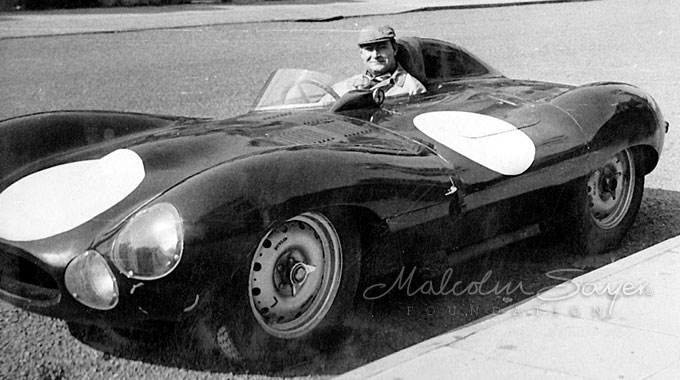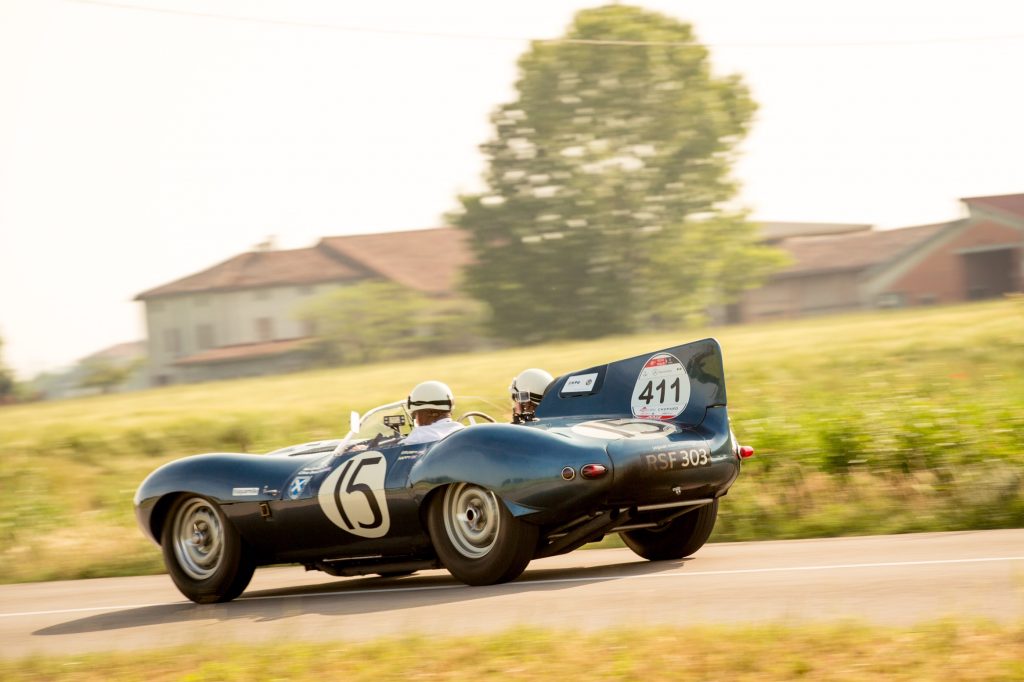Built primarily for racing, the D-types innovative monocoque construction introduced Malcolm’s aviation industry engineering knowledge to competition car design, with an aeronautical understanding of aerodynamic efficiency – proving to be a wining formula. Winning the Le Mans 24-hour race in 1955, 1956 and 1957, the D-Type’s aerodynamic superiority enabled maximum speeds of 172.8 mph on the Mulsanne Straight compared with the mechanically more powerful Ferrari’s 160.1 mph.

Malcolm sat in the ‘bobtail’ D-type.
The revolutionary design of the “tub”, or cockpit section, was of monocoque construction, mostly comprising sheets of aluminium alloy and its elliptical shape and comparatively small cross-section provided torsional rigidity and reduced drag. Reducing underbody drag contributed to the car’s high top speed – the cars iconic fin was mounted behind the driver for aerodynamic stability on the long Mulsanne Straight at Le Mans.
Fran Oldham, who worked with Malcolm at Jaguar during the development of the D-type recounts this story:
I was very mere when he was the competition car designer. But we liked each other and used to work together when a car was being tested, at MIRA or elsewhere. I would be sent from the Experimental Department, sometimes to drive something, more often to change wheels and tires or measure brake disc temperature or something of that sort. I do remember a couple of times when the D-type was being tested (once driven by Norman) at Gaydon when it was still RAF and I was sent to do tire pressures or other chores. The main runway there was one of the few places with a long enough straight to allow the D-type to reach maximum speed. The route we used was a P-shape, with the main runway as the upright stroke and a sort of makeshift pit area at the bottom of the loop of the P.
One time, the clear plastic covers over the headlamps hadn’t arrived and were temporarily replaced by hand-bashed alloy covers, held on with a couple of sheet-metal screws. Norman did several complete laps and came back with comments or results. We could here the car as he changed up through the gears and then the steady but receding bellow of the exhaust as he reached the end of the runway. After several such forays, Bob Knight, who was the head of the Experimental department, my boss, and later Chief Engineer, I think, told us to take the headlamp covers off… he didn’t really believe they were necessary. Malcolm said something to the effect that the front wheels would come off the ground at about 130 or 140 if you took them off. Bob told Norman to do a couple more laps. Norman shrugged and took off. We heard the car accelerate up through the gears after he turned at the end of the main runway and started down the full length. Part-way down the length we heard the engine shut off. A bit later the car came trickling back and stopped close to all the rest of us. Norman got out and said “Put the fookers back!” Neither Malcolm nor Bob Knight said anything.
In 1995, the D-Types were fitted with a longer nose, which further increased maximum speed; and the headrest fairing and aerodynamic fin were combined as a single unit that smoothed the aerodynamics and saved weight. With rear suspension and innovative all-round disc brakes retained from the C-Type, the XK engine was further revised as development progressed during the D-Type’s competition life.

XKD 603 – probably the most original long nose D in the world. Works (Hawthorn) car in 1956 and then to Ecurie Ecosse where she came 2nd at Le Mans in 1957. Picture courtesy of Clive Beecham.
In the 1955 Le Mans, a D-Type driven by Mike Hawthorn and Ivor Bueb won, and in 1956 the race was won by a D-Type entered by the now infamous small Edinburgh-based team Ecurie Ecosse, driven by Ron Flockhart and Ninian Sanderson, beating works teams from Aston Martin and Scuderia Ferrari.

In America, the Cunningham team raced several D-Types. In 1955, for example, a 1954 works car on loan to Cunningham won the Sebring 12 Hours in the hands of Mike Hawthorn and Phil Walters, and in May 1956 the team’s entries for Maryland’s Cumberland national championship sports car race included four D-Types in Cunningham’s white and blue racing colors. Driven by John Fitch, John Gordon Benett, Sherwood Johnston and team owner Briggs Cunningham, they finished 4th, 5th, 7th and 8th respectively.
1957 was to be the D-Type’s most successful year, with Ecurie Ecosse winning again, and also second place – all in all 5 of the 6 top places were taken by D-Types as they dominated Le Mans – the best result in the D-Type’s racing history.
A total of 18 factory team cars and 53 customer cars were built, and the remaining unfinished D-Types were developed as XKSS versions with extra road-going equipment, making them eligible for production sports car races in America. Sadly nine of these were destroyed in factory fire in 1957. Steve McQueen is perhaps the most notable owner of an XKSS. As detailed on Steve McQueen online:
He collected so many speeding tickets in it that he had his drivers license suspended twice.
On one occasion, when with his 6 months pregnant wife Neile in the passenger seat, he was pulled over for speeding, he came up with the false excuse that she was in labour. The police dutifully raced them to the hospital, where a nurse rushed out to help Neile.
After the police had departed Steve informed the nurse that it was a ‘False Alarm’, and led Neile back to the Jag. Writer William Nolan quotes Steve on the incident: “Neile was pissed. She didn’t speak to me for the rest of the day. But, by God, it worked. I didn’t get the ticket!”
Steve originally purchased the car in 1959, then sold it in 1969, but nostalgia got the best of him and he repurchased it in 1977, owning it till his death in 1980.

